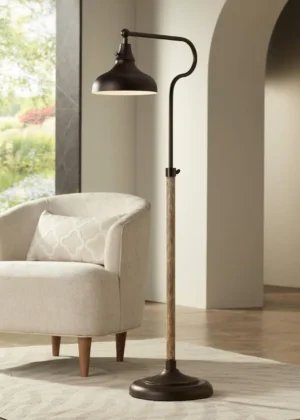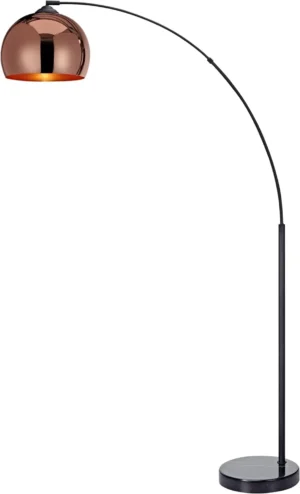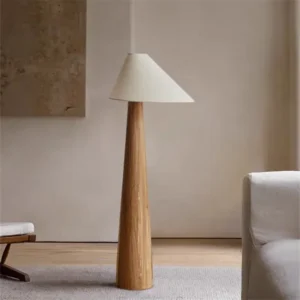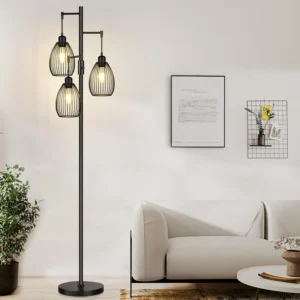Few things are more frustrating than a beautiful floor lamp that won’t stand straight. Beyond being an eyesore, leaning lamps create safety hazards and detract from your carefully designed interior space. With quality floor lamps often representing a significant investment, replacing them isn’t always the best option—especially when most stability issues can be fixed with the right approach.
Whether your lamp has suddenly started tilting or has always had a slight lean, solutions exist for every situation. The good news is that most fixes don’t require professional help or specialized skills. From simple tightening of loose components to more involved repairs, this guide will walk you through everything you need to know to restore stability to your favorite lighting fixture.
Throughout this guide, we’ll explore common causes of leaning lamps and provide practical, step-by-step solutions you can implement today. Understanding the ultimate guide to arc floor lamp bases can help identify issues early, while knowing how to stabilize arc floor lamp bases provides targeted solutions for these particularly challenging designs.
Why Floor Lamps Lean: Diagnosing the Root Causes
Before attempting any repair, it’s crucial to identify exactly why your lamp is leaning. Taking time for proper diagnosis ensures you address the actual problem rather than just treating symptoms. The most common causes include:
Loose connections: When parts of the lamp pole or the connection between the pole and base become loose, the entire structure can begin to tilt. Look for obvious wobbling at connection points when you gently move the lamp.
Uneven flooring: Sometimes the problem isn’t with the lamp at all, but with the surface it stands on. Carpet edges, transitions between flooring types, or naturally uneven floors can cause even perfectly assembled lamps to lean.
Inadequate base weight: Particularly for taller designs or those with extended arms, the base may simply not provide enough counterbalance for the lamp’s height and design.
Bent or damaged poles: Physical damage from impacts or poor handling can bend lamp poles, creating a permanent lean if not addressed.
Worn or stripped threads: After years of use or frequent adjustments, the threaded connections in your lamp may wear down, preventing parts from securing tightly.
Improper assembly: If a lamp was incorrectly assembled initially, structural imbalance can cause persistent leaning.
Many leaning lamps suffer from multiple issues simultaneously. For example, a slightly uneven floor might not cause problems until connections also loosen over time. Successful prevention of arc lamps tipping often requires addressing several factors together.
Essential Safety Precautions Before You Begin Repairs
Safety should always be your priority when working with any electrical fixture. Before attempting repairs:
Always unplug the lamp completely. Never work on a lamp that’s connected to power, even if the switch is off. Electrical shock can cause serious injury or death.
Clear your work area of obstacles and fragile items. Give yourself plenty of space to maneuver the lamp without risking damage to other belongings.
Handle glass components with extreme care. If your lamp has glass shades or decorative elements, consider removing them during repairs to prevent breakage.
Wear work gloves when handling metal components, particularly if there are any sharp edges or if you’ll be bending metal parts.
Keep basic tools handy, including screwdrivers (both Phillips and flathead), pliers, a level, and adjustable wrenches. Having the right tools ready makes repairs safer and more efficient.
Solution 1: Tightening Loose Connections for Immediate Stability
Loose connections are the most common cause of leaning floor lamps and often the easiest to fix. This systematic approach will help stabilize most lamps quickly:
Start at the base of the lamp and work your way up, checking each connection point. Pay particular attention to where the main pole connects to the base and where pole sections join together.
For threaded connections, use an appropriate wrench to gently tighten. Be careful not to overtighten, as this can strip threads or crack components. For screw connections, use the correct size screwdriver to ensure you don’t damage the screw head.
If connections loosen repeatedly, consider these advanced fixes:
Add a washer or rubber O-ring between components to provide better grip and prevent loosening. Hardware stores carry assorted washer sets perfect for this purpose.
Apply PTFE tape (also called plumber’s tape) to threaded connections. Wrap the tape clockwise around the threads 2-3 times before reassembling for a more secure fit.
For a more permanent solution, apply a small amount of thread-locking compound to the threads. Choose a medium-strength variety that will still allow future disassembly if needed.
If you encounter stripped threads, you may be able to repair them with a thread repair kit, or in less severe cases, by adding PTFE tape to build up the diameter of the threads. Understanding how to hide arc floor lamp cords properly can also prevent stability issues caused by cord tension.
Solution 2: Correcting Balance Issues on Uneven Floors
Uneven flooring is often overlooked as a source of lamp instability. Here’s how to address this common issue:
Use a small level placed on the lamp base to determine exactly how uneven the floor is. This will show you precisely where shimming is needed and how much correction is required.
For minor unevenness, try these shimming solutions:
- Thin cardboard, business cards, or playing cards make excellent improvised shims for slight corrections.
- Felt furniture pads, available in various thicknesses, provide a more finished look while protecting your flooring.
- Purpose-made furniture levelers can be attached to the base for adjustable correction.
For more substantial corrections:
- Cut custom wooden shims to the exact size needed.
- Use cork or rubber material for better grip and to prevent slippage.
To keep shims from slipping out of position, consider securing them with removable double-sided tape or adhesive putty. For a cleaner appearance, trim excess material so shims don’t extend beyond the lamp base.
For lamps that receive heavy use or frequent adjustment, consider marble base arc floor lamps which provide greater inherent stability due to their substantial weight and solid construction.
Solution 3: Adding Weight to Stabilize a Top-Heavy Lamp
When your lamp’s base isn’t heavy enough to properly support its height or extended arms, adding weight can significantly improve stability:
Commercial lamp weights designed specifically for this purpose are available in various sizes and designs. These donut-shaped weights slip over the lamp pole and rest on the base, adding ballast without changing the lamp’s appearance.
For DIY solutions, consider:
- Filling hollow bases with dense material such as sand, steel shot, or even pennies. To do this, look for a removable bottom plate or access point on the base.
- Creating a custom weight plate from steel or other heavy material that can sit underneath the lamp base. Cover with a decorative element if desired.
- Using adhesive weights (similar to wheel weights for cars) attached to the underside of the base where they won’t be visible.
As a general rule, the taller the lamp or the longer its arm extension, the more weight you’ll need to add. A typical arc-style floor lamp may require 5-15 pounds of additional weight for proper stability.
When adding weight, ensure it’s evenly distributed to maintain balance, and use felt pads under the base to prevent floor damage. Learning about weighted bases for arc lamps can provide specific guidance for these particularly top-heavy designs. For versatile lighting options, adjustable arc floor lamps can be positioned to minimize tipping risk in different configurations.
Solution 4: Fixing a Bent or Damaged Lamp Pole
When a lamp pole becomes bent or damaged, it can create a permanent lean that won’t resolve through other methods. Here’s how to address this more serious issue:
First, carefully assess whether the pole can be safely repaired. Minor bends in metal poles can often be straightened, but severe kinks or poles with significant structural damage may need replacement.
For straightening minor bends:
- Place the lamp on a flat, padded surface like a blanket.
- Identify the exact location of the bend.
- Using gentle, even pressure, gradually work to straighten the pole. Never force the metal, as this can cause breaks.
- For poles with internal wiring, take extreme care not to damage the insulation or wires during straightening.
If the lamp has telescoping or adjustable sections, disassemble these parts before attempting any straightening to avoid damaging the adjustment mechanisms.
When a pole is too damaged to repair safely, replacement may be the best option. Contact the manufacturer about replacement parts, or consider a lamp repair specialist. Many black arc floor lamps feature durable metal poles that resist bending and maintain their shape over time.
Solution 5: Repairing a Damaged or Unstable Lamp Base
A compromised base can be the root cause of persistent leaning. Here’s how to address various base issues:
For stripped screw holes in the base:
- Fill the hole with wood filler (for wooden bases) or epoxy putty (for metal or plastic bases).
- Allow to dry completely, then redrill a pilot hole slightly smaller than your screw.
- Reinsert the screw for a tight fit.
When dealing with a cracked base:
- Clean the surfaces thoroughly.
- Apply appropriate adhesive (wood glue for wooden bases, epoxy for metal or plastic).
- Clamp until fully cured.
- Reinforce with small metal brackets if needed.
For loose center poles in the base:
- Remove the pole completely.
- Clean out the socket in the base.
- Apply epoxy designed for the base material.
- Reinsert the pole, ensuring it’s perfectly vertical.
- Support in position until the epoxy cures.
If repairs aren’t feasible, replacement bases are sometimes available from manufacturers or specialty lighting repair shops. Understanding different arc lamp base types can help you identify compatible replacement options if needed.
Solution 6: Anti-Tip Solutions for Extra Security
Even after addressing the primary causes of leaning, additional security measures can provide peace of mind, especially in homes with children, pets, or in high-traffic areas:
Furniture anchoring systems designed for bookcases and cabinets can be adapted for floor lamps. These typically involve attaching a strap or cable between the lamp and a wall anchor.
For a less permanent option, consider:
- Heavy-duty double-sided tape between the lamp base and floor
- Non-slip rubber mats under the base
- Furniture wedges to prevent movement
- Strategic placement against walls or in corners where the lamp has natural support
When choosing an anchoring method, balance security needs with aesthetic concerns. Many modern solutions are discreet and barely noticeable when properly installed.
For comprehensive information about keeping taller designs upright, our guide on how to secure tall floor lamps offers additional specialized techniques and product recommendations.
Essential Tools and Materials for Floor Lamp Repairs
Having the right tools and materials on hand makes lamp repairs much easier and more successful:
Basic Tools:
* Screwdriver set with various Phillips and flathead sizes
* Adjustable wrench or set of wrenches
* Small bubble level
* Pliers (regular and needle-nose)
* Wire cutters (for lamps requiring electrical work)
* Measuring tape
Materials for Various Repairs:
* Assorted washers and nuts
* PTFE plumber’s tape
* Medium-strength thread-locking compound
* Furniture felt pads in various thicknesses
* Epoxy suitable for metal, wood, or plastic
* Shim materials (cardboard, plastic, wood)
* Weighting materials (sand, steel shot)
Most of these supplies can be found at hardware stores or home improvement centers. For specialty lamp parts, lighting supply stores or online retailers specializing in lamp repair offer comprehensive options.
For wooden arc floor lamps, keep wood glue and matching wood filler on hand, as these materials require specific repair approaches different from metal lamps.
Preventative Maintenance to Avoid Future Leaning Issues
Regular maintenance can prevent many stability problems before they develop:
Establish a quarterly maintenance routine to check all connections and tighten as needed. Mark your calendar or set a recurring reminder to ensure this doesn’t get overlooked.
When moving lamps, always lift from the base rather than pulling on the pole or shade. This prevents stress on connection points and keeps everything properly aligned.
Be aware of seasonal changes that might affect your lamp’s stability. Wood can expand and contract with humidity variations, and flooring may shift slightly with temperature changes, requiring occasional readjustment.
Adjustable Arc Floor Lamp, Bronze Arc Floor Lamp
Price range: $440.95 through $558.52 Select options This product has multiple variants. The options may be chosen on the product pageContemporary Arc Floor Lamp, Large Arc Floor Lamp, Marble Base Arc Floor Lamp
$224.94 Select options This product has multiple variants. The options may be chosen on the product pageMid-Century Arc Floor Lamp, Wood Arc Floor Lamp
$230.86 Select options This product has multiple variants. The options may be chosen on the product pageVintage Arc Floor Lamp, Wood Arc Floor Lamp
Price range: $603.87 through $1,346.09 Select options This product has multiple variants. The options may be chosen on the product page- $1,003.85 Select options This product has multiple variants. The options may be chosen on the product page
3 Light Arc Floor Lamp, Dimmable Arc Floor Lamp
Price range: $162.86 through $246.50 Select options This product has multiple variants. The options may be chosen on the product page
Manage cords properly to prevent pulling that could gradually shift the lamp position. Use cord covers or guides to route cords away from foot traffic.
Watch for early warning signs like slight wobbling, unusual noises when the lamp is touched, or visible gaps at connection points. Addressing these immediately prevents more serious stability issues. Our complete guide to stabilizing floor lamp bases offers additional preventative strategies.
When to Replace Your Floor Lamp: Signs It’s Time to Shop
Despite your best efforts, sometimes replacement is the most sensible option. Consider a new lamp when:
- Electrical components show signs of damage or malfunction, creating safety hazards
- The structural integrity is compromised beyond reasonable repair
- Multiple repair attempts have failed to resolve the leaning issue
- The cost of specialized repairs exceeds the value of the lamp
For vintage or designer lamps with significant value, consult with a professional lighting restorer before deciding on replacement. These specialists can often perform repairs that would be impractical for DIY methods.
When choosing a replacement lamp, look for features that promote better stability:
- Wider, heavier bases proportional to the lamp’s height
- Quality construction with secure connection methods
- Adjustable leveling feet
- Models with lower centers of gravity
Many modern dimmable arc floor lamps incorporate improved stability features while adding functional lighting control.
Special Considerations for Different Floor Lamp Types
Different lamp designs present unique stability challenges:
Arc floor lamps with their extended reach require special attention to counterbalancing. Their long reach creates significant leverage that can cause tipping if the base isn’t proportionally weighted. Consider additional base weights specifically for these designs.
Multi-head or tree-style lamps distribute weight unevenly, especially when adjustable arms are positioned asymmetrically. When adjusting these lamps, maintain reasonable balance between the arms rather than extending them all in one direction.
Adjustable-height lamps often have mechanisms that can loosen over time. Regular checks of the height adjustment components help prevent unexpected slipping or tilting.
Tripod lamps rely on the even distribution of weight across all three legs. Ensure all legs make solid contact with the floor and that the center joint remains tight.
Interior Ivy offers a variety of floor lamps with stable base designs for arc floor lamps that address these common stability concerns through thoughtful engineering and quality materials.
By understanding the specific needs of your lamp type and applying the appropriate stability solutions, you can enjoy beautiful, functional lighting without the frustration of constant adjustments or safety concerns. With proper care and maintenance, your floor lamp will stand tall and straight for years to come.






